Nov 24, 2020
The stats didn’t look good today. I made a lot less profit than I did yesterday. After pausing and reducing the budgets of many campaigns, the old winning products still didn’t perform well. Most of them were in the declining phase of their product life cycle.
The good news was that I had new winning products: Product #10 and #11. After adding more campaigns and budget to these products, they made many sales with a very low CPP. Just like Product #2 in its early days.
We’ll go into detail on those products soon.
For now, this was the overall performance of every product today:
Product #1
Sales: 176
Revenue: $4,010.45
Spent: $2,422.44
CPP: $13.70
Profit: $1,588.01
Product #2
Sales: 792
Revenue: $18,136.80
Spent: $16,450.48
CPP: $19.34
Profit: $2,819.9
Product #3
Sales: 305
Revenue: $6,984.50
Spent: $3,263.15
CPP: $10.70
Profit: $3,721.35
Product #6
Sales: 83
Revenue: $1,900.70
Spent: $811.29
CPP: $9.70
Profit: $1,089.41
Product #7
Sales: 78
Revenue: $1,786.20
Spent: $1,098.10
CPP: $14.67
Profit: $642.1
Product #8
Sales: 53
Revenue: $1,059.09
Spent: $486.19
CPP: $9.17
Profit: $572.9
Product #10
Sales: 151
Revenue: $3,306.90
Spent: $689.29
CPP: $4.56
Profit: $2,617.61
Product #11
Sales: 586
Revenue: $6,984.50
Spent: $591.87
CPP: $1.01 (Yikes!)
Profit: $6,392.63
Product #12
Sales: 6
Revenue: $137.40
Spent: $0
CPP: $0
Profit: $137.4
Overall Performance
Sales: 2,230
Revenue: $44,306.54
Spent: $24,862.63
CPP: $11.14
Profit: $19,443.91
As you can see, the CPPs of Product #1 and #2 was still increasing, even after I lowered their budgets.
If a product has been running for a while and the CPP keeps increasing even after we lower the budget, it means the product might be in decline and we shouldn’t add more budget to it.
It wasn’t a good day for Product #1 and #2.
Here are the stats for Product #1:
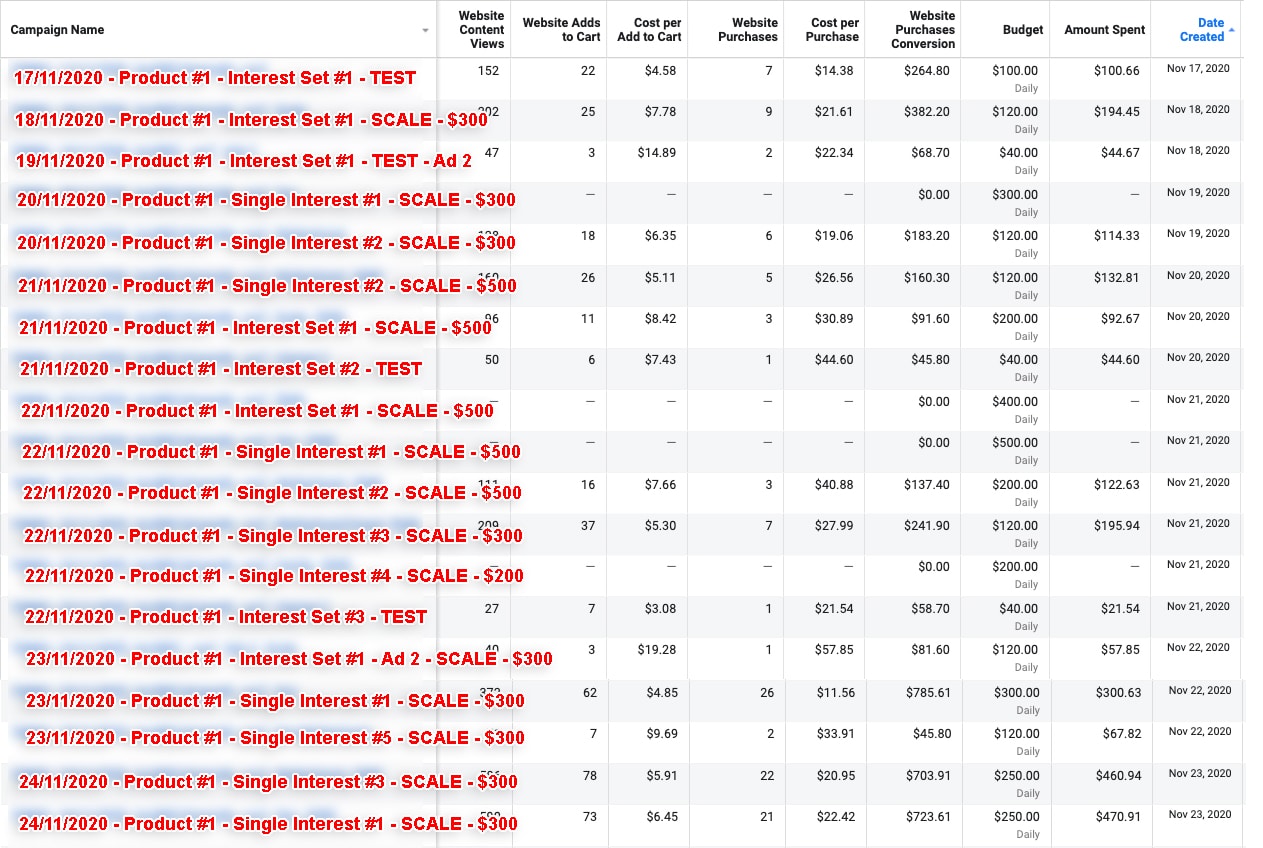
Only two of them had a CPP lower than $15, and none of them had a CPP of less than $10. It was clearly time to scale down this product.
I kept reducing the budget and pausing non-performing campaigns. I created only two new campaigns today, and gave them daily budgets of only $200 and $300.
Let’s move on to Product #2.
The CPP of this product almost doubled from yesterday. The profit also significantly dropped, from almost $16k to around $3k.
But when I checked the stats for Product #11, I was still chill with it. I knew that people who saw the Ads for Product #2 would see many links to Product #11 in the comments.
There were 586 sales from Product #11, and only $591.87 of ad spend. It meant that many of the sales for Product #11 came from ads for Product #2.
The stats for Product #2 in Ad Manager didn’t look bad:



The average CPP on Ad Manager for this product increased from $14.51 to $15.99, so I just kept pausing and reducing the budget for certain campaigns.
I also soft-scaled by duplicating good-performing campaigns. I chose 6 Single Facebook Interest Campaigns that had a CPP lower than $15 to duplicate and set the daily budget to $300.
This time, I created a Lookalike Audience from the people who visited the landing page of Product #2 and used this audience to create a campaign. I set the daily budget for this campaign to $300.
I created the Lookalike campaign in the same way I created the Single Facebook Interest Campaign. One campaign will have five ad sets with the same Lookalike Audience.
I added $2,100 to this product today.
I didn’t think I could keep scaling Product #2 aggressively. It was better to add more budget to Product #11.
These are yesterday’s stats from Product #11. I started scaling it by creating many campaigns for it.
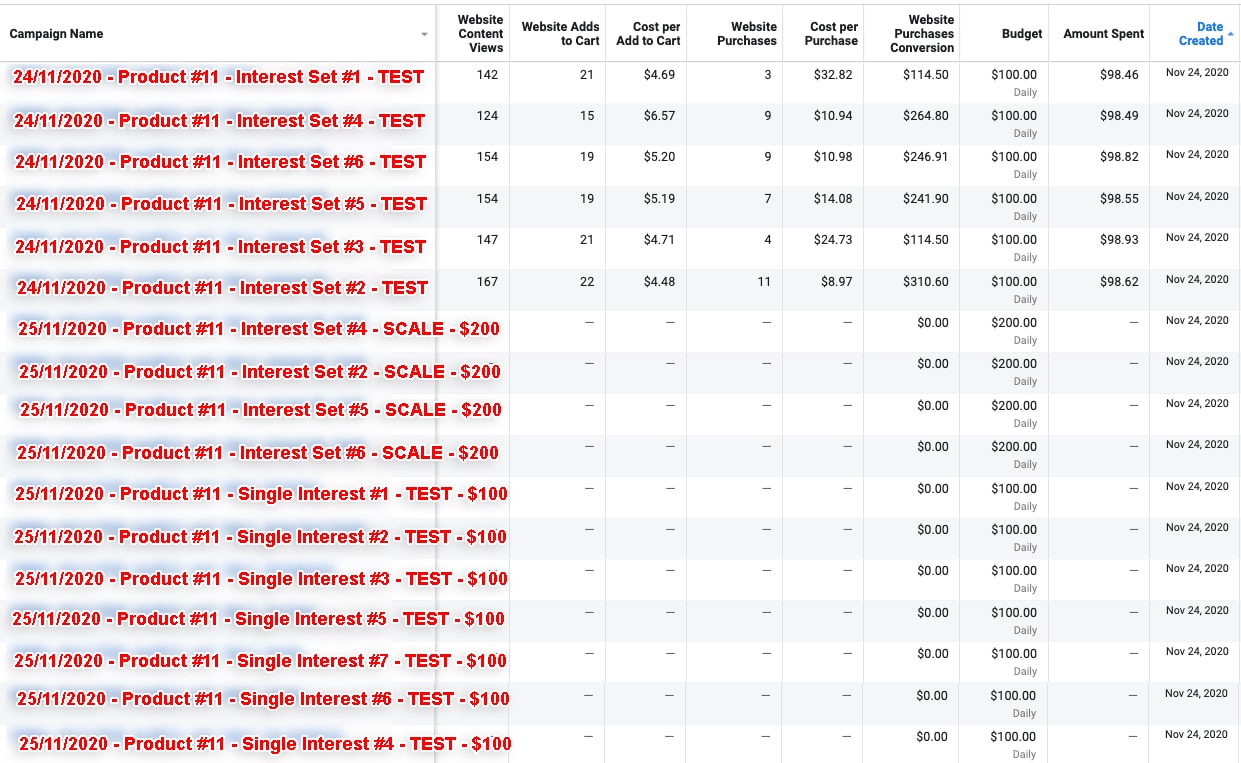
These were the stats of the ad sets inside some of the winning campaigns:




You can see that many ad sets made at least one sale with a CPP lower than $10. I chose a few of them to create new campaigns with a $100 budget. I didn’t choose all the good ad sets to scale this time, because it would be too soon to scale this product.
For Interest #3, you might be curious why I chose it to create a new campaign because its CPP was as high as $21.78 per sale. The reason I chose this Interest is because I knew that it had been a winning interest for my old products. I also found that 9 people had added this product to their cart, and the cost per add to cart was only $4.84. I was pretty sure this product could a winner.
Also, I duplicated 4 Multiple Facebook Interest Campaigns that performed well yesterday and set the daily budgets to $200 each.
The total added to this product was $1,500.
Okay, that’s all for Product #11. Next, let’s look at another similar product that had been performing well: Product #10.
Product #10 was selling really well after I added $600 to it. I spent $689.29 and made 151 sales (around $3,300). The CPP was around $4.56.
These are probably the stats of a BIG winning product.
You can see the stats for this product below:

This was easy for me to scale. I just duplicated the ones that were performing well today (all of them, actually) and set the daily budget to $300 each. Then, I created new campaigns from the winning Facebook Interests I found and set the daily budgets to $100. And I expanded the audience by creating Multiple Facebook Interests campaigns with all new Facebook Interests and set the daily budget to $100.
There was $1,700 added to this product. I was sure that Product #10 and Product #11 would be the next BIG winning products that could make over 5-figures a day in total.
Let’s return to Product #3.
After pausing and reducing the budgets of many campaigns, the total spending for this product was reduced to just around $200 and the CPP remained almost the same. But the profit decreased by almost $700.
The stats didn’t look good, but there were still some good- performing campaigns:
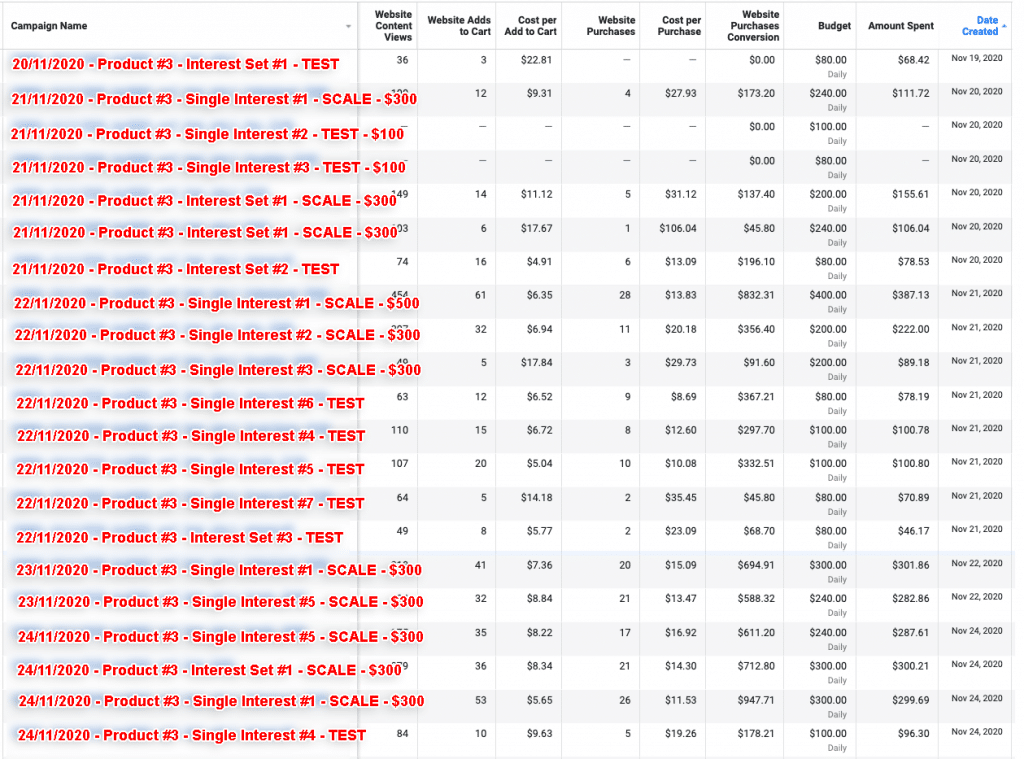
I still did the same thing I did every day - paused the non-performing one and reduced the budgets for campaigns whose CPP was over $15.
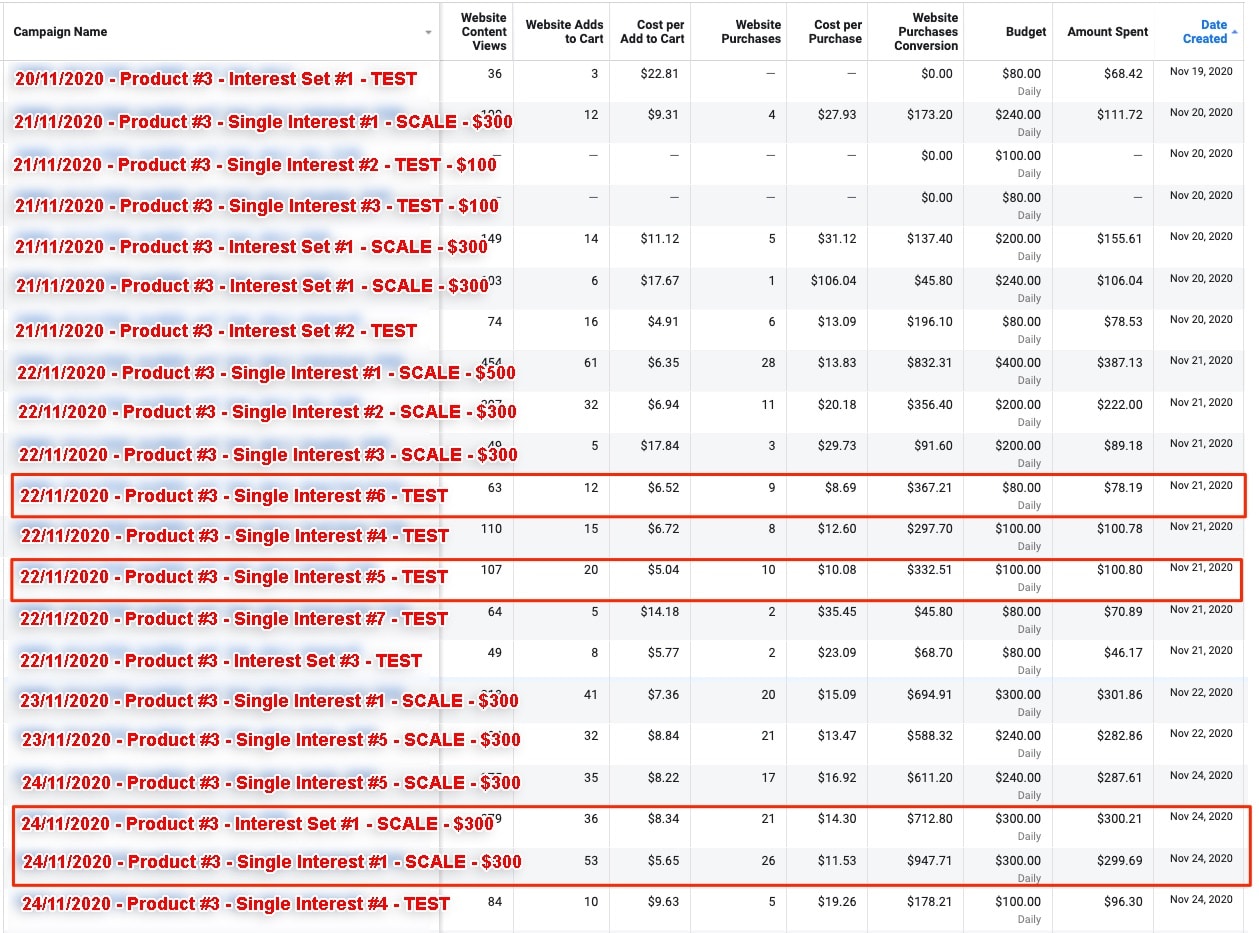
I duplicated some good campaigns to new ones and set the daily budgets to $300 each.
I added $1,200 to this product.
I thought Product #3 was already been in the declining phase, so I started creating campaigns for Product #12 today.
In case you forgot, Product #12 contained a design that tweaked from Product #3, in the same way I created Product #11 from Product #2. I thought Product #12 might replace Product #3.
In my opinion, instead of scaling the old campaigns that had sold thousands units and whose CPP kept increasing, it was better to put budget to the new, similar product.
So I created new campaigns for Product #12. Here they are:

For this product, I created 4 Multiple Facebook Interest Campaigns and set the daily budget to $100 for each one.
That’s all for Product #12.
For Product #6, I didn’t do anything much. Although the CPP from my calculations was around $9.70, I thought most of the sales came from somewhere else, not from the ads.
You can see the Ad Manager stats below:

I just paused some ad sets and reduced the budget of some campaigns. I duplicated one campaign that had looked good over the past few days and set its daily budget to $300.
The stats for Product #7 looked a bit better than they did yesterday. The CPP decreased a little and the profits increased slightly.
The stats are below:
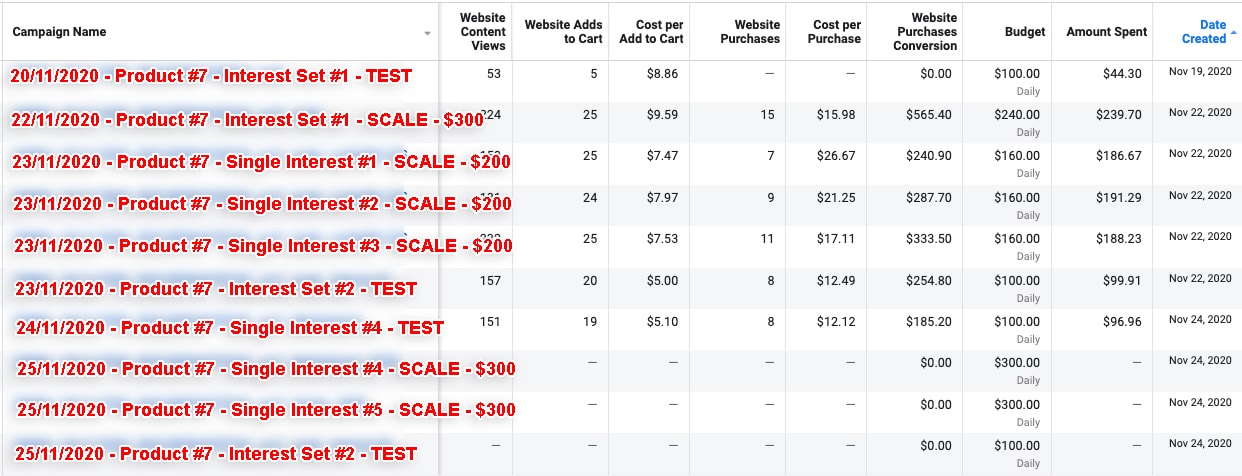
So I duplicated one good campaign and set the daily budget to $300.
I also created another campaign from one Facebook Interest and set the daily budget to $300, because this interest had been running for a few days and produced good results.

I created another Multiple Facebook Interest Campaign with a daily budget of $100.
I still thought I couldn’t scale this product aggressively like I did for Product #2, #10, and #11, which were all in the same niche.
You may have noticed that the CPP of Product #2, #10 and #11 were very low compared to Product #7. So I didn’t scale this one scale hard.
That’s all for this product.
Okay, it seems like I found some new BIG products – Product #10 and #11 – and I could bounce back and continue making higher profits.
But something I’d been praying wouldn’t happen, happened. I’ll talk about it tomorrow.